| 1970s . 1980s in video games . 1990s |
| Other topics: Anthropology . Comics . Fashion . Music . Science and technology . Sociology |

The 1980s was the second decade in the industry's history. It was a decade of highs and lows for video games. The decade began amidst a boom in the arcade business with giants like Atari still dominating the American market since the late-1970s. Another, the rising influence of the home computer, and a lack of quality in the games themselves led to an implosion of the video game market that nearly destroyed the industry in North America.[1] It took home consoles years to recover from the crash, but Nintendo filled in the void with its Nintendo Entertainment System (NES, Famicom), reviving interest in consoles.[2] Up until this point, most investors believed video games to be a fad that has since passed.[3] In the remaining years of the decade, Sega ignites a console war with Nintendo, developers that had been affected by the crash experimented with the more advanced graphics of the PC,[4] and Nintendo released the Game Boy, which would become the best-selling handheld gaming device for the next two-decades.[5] Other consoles releases in the decade included the Intellivision, TurboGrafx-16 (PC Engine) and Sega Genesis (Mega Drive). Notable games of the 1980s included Super Mario Bros, Duck Hunt, Metroid, Elite, SimCity, Galaga, Pitfall!, Frogger, Mike Tyson's Punch-Out!!, Defender, Mega Man 2, The Legend of Zelda, Castlevania, Ghosts 'n Goblins, Super Mario Bros. 2, Bubble Bobble, Double Dragon, Final Fight, Ninja Gaiden, Tetris, Adventure, Joust, Robotron: 2084, Pac-Man, Dig Dug, Arkanoid, Populous, R-Type, Contra, Donkey Kong, Centipede, Super Mario Bros. 3, Prince of Persia, Gauntlet, Dragon's Lair, Golden Axe, Ms. Pac-Man, Out Run, Final Fantasy, Altered Beast, Shinobi, Lode Runner, Battlezone, Dragon Quest, and Marble Madness.
Consoles of the 1980s
Third generation consoles (1983–1993)
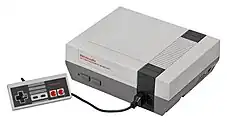
Starting in 1983 the third generation began with the Japanese release of the Family Computer (or "Famicom"; later known as the Nintendo Entertainment System in the rest of the world) by Nintendo. Although the previous generation of consoles had also used 8-bit processors, it was at the end of this generation that home consoles were first labeled by their "bits". This also came into fashion as 16-bit systems like Sega's Genesis were marketed to differentiate between the generations of consoles. In the United States, this generation in gaming was primarily dominated by the NES/Famicom. Other notable consoles included Sega's Mark III, also known as the Master System.
Early Fourth generation consoles (1987–1996)
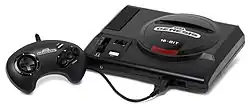
Starting in 1987 with the PC Engine in Japan and ending in 1996, with the last console being the Neo-Geo in 1991, the fourth generation of video game consoles consisted primarily of games and systems programmed for the 16-bit era. During this generation, 2D graphics had improved over the previous generation and experimentation began to occur with 3D graphics, although 3D games were more prevalent on the PC at the time. The fourth generation also was the first time compact discs were considered a viable port for video game retail sales with the CD-i. Some of the most notable systems released during this generation were the Super Famicom/Super Nintendo Entertainment System (1990), the Sega Mega Drive/Genesis (1988), and the Neo Geo (1991).[6] Nintendo's Game Boy was also released during the fourth generation, which would later become the most popular series of handheld gaming systems during the 1990s.[7] A rivalry between Sega and Nintendo occurred during this generation, starting the first ever console war.
History
Golden age of arcade games
In the early-1980s, arcade games were a vibrant industry. The arcade video game industry in the US alone was generating $5 billion of revenue annually in 1981[8] and the number of arcades doubled between 1980 and 1982.[9] The effect video games had on society expanded to other mediums as well such as major films and music. In 1982, "Pac-Man Fever" charted on the Billboard Hot 100 charts[10] and Tron became a cult classic.[11]
Third-party development and an oversaturated market
Following a dispute over recognition and royalties, several of Atari's key programmers split and founded their own company Activision in late 1979.[12] Activision was the first third-party developer for the Atari 2600.[13] Atari sued Activision for copyright infringement and theft of trade secrets in 1980,[14] but the two parties settled on fixed royalty rates and a legitimizing process for third parties to develop games on hardware.[15]
In the aftermath of the lawsuit, an oversaturated market resulted in companies that had never had an interest in video games before beginning to work on their own promotional games; brands like Purina Dog Food.[16] The market was also flooded with too many consoles and too many poor quality games,[17] elements that would contribute to the collapse of the entire video game industry in 1983.
Video game crash of 1983
By 1983, the video game bubble created during the golden age had burst and several major companies that produced computers and consoles had gone into bankruptcy.[18] Atari reported a $536 million loss in 1983.[19] Some entertainment experts and investors lost confidence in the medium and believed it was a passing fad.[20] A game often given poster child status to this era, E.T. the Extra-Terrestrial had such bad sale figures that the remaining unsold cartridges were buried in the deserts of New Mexico.[21][22]
Rise of computer gaming
The brunt of the crash was felt mainly across the home console market. Home computer gaming continued to thrive in this time period, especially with lower-cost machines such as the Commodore 64 and ZX Spectrum. Some computer companies adopted aggressive advertising strategies to compete with gaming consoles and to promote their educational appeal to parents as well.[23][24] Home computers also allowed motivated users to develop their own games, and many notable titles were created this way, such as Jordan Mechner's Karateka, which he wrote on an Apple II while in college.[25]
In the late 1980s, IBM PC compatibles became popular as gaming devices, with more memory and higher resolutions than consoles, but lacking in the custom hardware that allowed the slower console systems to create smooth visuals.[26]
Rejuvenation
By 1985, the home market console in North America had been dormant for nearly two years. Elsewhere, video games continued to be a staple of innovation and development. After seeing impressive numbers from its Famicom system in Japan, Nintendo decided to jump into the North American market by releasing the Nintendo Entertainment System, or NES for short. After release it took several years to build up momentum, but despite the pessimism of critics it became a success. Nintendo is credited with reviving the home console market.[2]
One innovation that led to Nintendo's success was its ability to tell stories on an inexpensive home console; something that was more common for home computer games, but had only been seen on consoles in a limited fashion. Nintendo also took measures to prevent another crash by requiring third-party developers to adhere to regulations and standards, something that has existed on major consoles since then. One requirement was a "lock and key" system to prevent reverse engineering. It also forced third parties to pay in full for their cartridges before release, so that in case of a flop, the liability will be on the developer and not the provider.[27]
Notable video-game franchises established in the 1980s
Arcades
- 1942 (1984)
- After Burner (1987)
- Altered Beast (1988)
- Arkanoid (1986)
- Balloon Fight (1984)
- Baraduke (1985)
- Bionic Commando (1987)
- Bomb Jack (1984)
- Bubble Bobble (1986)
- BurgerTime (1982)
- Centipede (1981)
- Contra (1987)
- Darius (1987)
- Defender (1981)
- Dig Dug (1982)
- Donkey Kong (1981)
- Double Dragon (1987)
- Dragon's Lair (1983)
- Fantasy Zone (1986)
- Final Fight (1989)
- Frogger (1981)
- Gauntlet (1985)
- Ghosts 'n Goblins (1985)
- Golden Axe (1989)
- Golden Tee Golf (1989)
- Gradius (1985)
- Hang-On (1985)
- Joust (1982)
- Kunio-kun (1986)
- Ikari Warriors (1986)
- Mappy (1983)
- Missile Command (1980)
- Mr. Do! (1982)
- Ninja Gaiden (1988)
- OutRun (1986)
- Pac-Man (1980)
- Paperboy (1985)
- Pocky & Rocky (1986)
- Pole Position (1982)
- Punch-Out!! (1984)
- Q*bert (1982)
- Qix (1981)
- Rally-X (1980)
- Rampage (1986)
- Robotron: 2084 (1982)
- R-Type (1987)
- Shinobi (1987)
- Space Harrier (1985)
- Spy Hunter (1983)
- Street Fighter (1987)
- Strider (1989)
- Tempest (1981)
- Track & Field (1983)
- Tron1 (1982)
- TwinBee (1985)
- Wonder Boy (1986)
- World Stadium (1988)
- Xevious (1982)
- Zaxxon (1982)
Consoles and home computers
- Adventure Island (1986)
- Alien1 (1982)
- Alternate Reality (1985)
- Alex Kidd (1986)
- The Bard's Tale (1985)
- Batman1 (1986)
- BattleTech (1988)
- Blaster Master (1988)
- Bomberman (1983)
- Bonk (1989)
- Boulder Dash (1984)
- Carmen Sandiego (1985)
- Castlevania (1986)
- Choplifter (1982)
- Dizzy (1987)
- Dragon Ball1 (1986)
- Dragon Quest (1986)
- Dragon Slayer (1984)
- Dungeons & Dragons (1988)
- Dungeon Explorer (1989)
- Dungeon Master (1987)
- Elite (1984)
- Excitebike (1984)
- Famicom Detective Club (1988)
- Family Stadium (1986)
- Final Fantasy (1987)
- Fire Pro Wrestling (1989)
- G.I. Joe1 (1983)
- Godzilla1 (1983)
- Horace (1982)
- James Bond1 (1983)
- Jetpac (1983)
- Kid Icarus (1986)
- King's Quest (1980)
- Last Ninja (1987)
- The Legend of Heroes (1989)
- The Legend of Zelda (1986)
- Leisure Suit Larry (1987)
- Lode Runner (1983)
- Madden NFL (1988)
- Maniac Mansion (1987)
- Manic Miner (1983)
- MechWarrior2 (1989)
- Mega Man (1987)
- Megami Tensei (1987)
- Metal Gear (1987)
- Metroid (1986)
- Microsoft Flight Simulator2 (1982)
- Middle-earth1 (1982)
- Might and Magic (1986)
- Mother (1989)
- Parodius (1988)
- Phantasie (1985)
- Phantasy Star (1987)
- Pitfall! (1982)
- Police Quest (1987)
- Populous (1989)
- Prince of Persia (1989)
- The Prisoner1 (1980)
- RealSports (1982)
- RoboCop1 (1988)
- Rocky's Boots (1982)
- Romance of the Three Kingdoms (1985)
- SaGa (1989)
- Shadow of the Beast (1989)
- SimCity (1989)
- Space Quest (1986)
- Spider-Man1 (1982)
- Star Raiders (1980)
- Star Soldier (1986)
- Super Mario (1985)
- Teenage Mutant Ninja Turtles1 (1989)
- Test Drive (1987)
- Tetris (1985)
- Thunder Force (1983)
- Ultima (1981)
- Wasteland (1988)
- Wizardry (1981)
- Wolfenstein (1981)
- X-Men1 (1989)
- Ys (1987)
Notes:
- 1Game franchises that also accompany major film or television franchises.
- 2Game franchises that are considered spin-offs of previously established franchises.
Financial performance
Highest-grossing arcade games of the decade
The following titles were the highest-grossing arcade video games of each year in the 1980s, in terms of coin drop earnings.
| Year | Market | Chart(s) | Title | Revenue | Inflation | Developer | Manufacturer(s) | Genre | Ref |
|---|---|---|---|---|---|---|---|---|---|
| 1980 | Worldwide | — | Pac-Man | $6 billion | $18 billion | Namco | Namco / Midway | Maze | [28][29] |
| 1981 | |||||||||
| 1982 | |||||||||
| 1983 | Worldwide | — | Pole Position | Unknown | Namco | Namco / Atari | Racing | [30] | |
| 1984 | UK | Unknown | Track & Field | Unknown | Konami | Konami | Olympic sports | [31] | |
| USA | AMOA | Pole Position | Unknown | Namco | Atari | Racing | [32] | ||
| RePlay | Pole Position II | Unknown | Namco | Atari | Racing | [33] | |||
| 1985 | UK | Unknown | Commando | Unknown | Capcom | Capcom | Run-and-gun | [31] | |
| USA | Play Meter | Hang-On | Unknown | Sega | Sega | Racing | [34] | ||
| RePlay | Karate Champ | Unknown | Technōs | Data East | Fighting | [35] | |||
| 1986 | Japan | Game Machine | Hang-On | Unknown | Sega | Sega | Racing | [36][37] | |
| UK | Electrocoin (London) | Nemesis (Gradius) | Unknown | Konami | Konami | Scrolling shooter | [38] | ||
| USA | Play Meter | Gauntlet | Unknown | Atari Games | Atari Games | Hack-and-slash | [39] | ||
| RePlay | Hang-On | Unknown | Sega | Sega | Racing | [40] | |||
| 1987 | Japan | Gamest / Game Machine | Out Run | Unknown | Sega | Sega | Driving | [41][42] | |
| USA | Play Meter | Sega | Sega | Driving | [43] | ||||
| 1988 | Japan | Gamest / Game Machine | After Burner | Unknown | Sega | Sega | Air combat | [44][45] | |
| Hong Kong | Bondeal | RoboCop | Unknown | Data East | Data East | Action | [46] | ||
| UK | Unknown | Operation Wolf | Unknown | Taito | Taito | Light gun shooter | [47] | ||
| USA | Play Meter | Double Dragon | Unknown | Technōs | Taito | Beat 'em up | [48] | ||
| 1989 | Japan | Dedicated cabinet | Final Lap | Unknown | Namco | Namco | Racing | [49] | |
| Conversion kit | Tetris | Unknown | Sega | Sega | Puzzle | [49][50] | |||
| USA | AMOA (dedicated) | Double Dragon | Unknown | Technōs | Taito | Beat 'em up | [51] | ||
| AMOA (conversion kit) | Capcom Bowling | Unknown | Strata | Capcom | Sports | ||||
| RePlay (dedicated) | Super Off Road | Unknown | Leland | Leland | Racing | [52] | |||
| RePlay (conversion kit) | Ninja Gaiden | Unknown | Tecmo | Tecmo | Beat 'em up | ||||
Best-selling home video games of the decade
The following table lists the top 20 best-selling home video games of the 1980s. Note that video game sales numbers were not as widely reported during the 1980s, with the exception of titles published by Nintendo and Atari, Inc.
Best-selling home systems of the decade
The following table lists the top 20 best-selling home systems in the 1980s, including home video game consoles, handheld game consoles, handheld electronic games, and personal computers.
| No. | System(s) | Manufacturer | Type | Generation | Release | Hardware sales | Software sales | ||||||
|---|---|---|---|---|---|---|---|---|---|---|---|---|---|
| Japan | USA | Europe | Korea | Worldwide | As of | USA | As of | ||||||
| 1 | Nintendo Entertainment System | Nintendo | Console | Third | 1983 | 14,630,000[78] | 20,800,000+[79] | 1,000,000[80] | 20,000[81] | 36,450,000 | 1989 | 101,500,000[82] | 1989 |
| 2 | Game & Watch | Nintendo | Handheld | — | 1980 | — | — | — | — | 18,600,000+[83][84] | 1982 | — | — |
| 3 | Atari 2600 (Atari VCS) | Atari | Console | Second | 1977 | — | — | — | — | 18,450,000+[85][86] | 1986 | Unknown | Unknown |
| 4 | Commodore 64 (C64) | Commodore | Computer | 8-bit | 1982 | — | — | — | — | 13,700,000[87] | 1989 | ||
| 5 | IBM Personal Computer (PC) | IBM | Computer | 8/16-bit | 1981 | — | — | — | — | 6,952,600+[lower-alpha 5] | 1989 | ||
| 6 | Apple II | Apple Inc. | Computer | 8-bit | 1977 | — | — | — | — | 4,487,000[87] | 1989 | ||
| 7 | NEC UltraLite / PC-88 / PC-98 | NEC | Computer | 8/16-bit | 1981 | 4,040,000[lower-alpha 6] | 211,000+[90] | Unknown | Unknown | 4,251,000+ | 1989 | ||
| 8 | Famicom Disk System | Nintendo | Console | 8-bit | 1986 | 4,000,000[91] | — | — | — | 4,000,000 | 1989 | ||
| 9 | MSX | ASCII Corp. | Computer | 8-bit | 1983 | — | — | — | — | 4,000,000[92] | 1989 | ||
| 10 | Sega SG-1000 / Master System | Sega | Console | Third | 1985 | 1,440,000[93] | 1,665,000+[94][95][96] | 700,000[80] | 130,000[81] | 3,935,000+ | 1989 | ||
| 11 | Apple Macintosh | Apple Inc. | Computer | 16-bit | 1977 | — | — | — | — | 3,502,000[87] | 1989 | ||
| 12 | Intellivision | Mattel | Console | Second | 1979 | — | — | — | — | 3,000,000+[97] | 1983 | ||
| 13 | Coleco Mini-Arcade | Coleco | Dedicated | — | 1982 | — | 3,000,000[98] | — | — | 3,000,000 | 1982 | — | — |
| 14 | PC Engine / TurboGrafx-16 | NEC | Console | 8/16-bit | 1987 | 2,350,000[78] | 300,000[99] | Unknown | Unknown | 2,650,000+ | 1989 | Unknown | |
| 15 | Game Boy | Nintendo | Handheld | 8-bit | 1989 | 1,480,000[78] | 1,000,000[79] | — | — | 2,500,000[100] | 1989 | ||
| 16 | ZX81 / ZX Spectrum | Sinclair | Computer | 8-bit | 1981 | — | — | — | — | 2,300,000[101] | 1984 | ||
| 17 | ColecoVision | Coleco | Console | Second | 1982 | — | 2,000,000[102] | Unknown | Unknown | 2,000,000+ | 1984 | ||
| 18 | Amstrad CPC | Amstrad | Computer | 8-bit | 1984 | — | Unknown | 2,000,000[103] | — | 2,000,000+ | 1989 | ||
| 19 | Atari 400 / Atari 800 | Atari | Computer | 8-bit | 1979 | — | — | — | — | 1,900,000[87] | 1989 | ||
| 20 | Amiga | Commodore | Computer | 16-bit | 1985 | — | — | — | — | 1,600,000[87] | 1989 | ||
Hardware timeline
The following gallery highlights hardware used to predominantly play games throughout the 1980s.
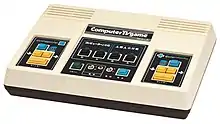 Computer TV-Game (1980)
Computer TV-Game (1980)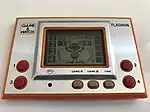 Game & Watch (1980)
Game & Watch (1980)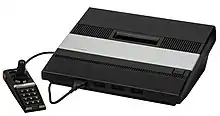 Atari 5200 (1982)
Atari 5200 (1982)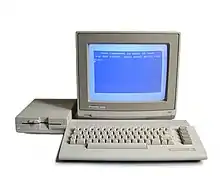 Commodore 64 (1982)
Commodore 64 (1982) Apple IIe (1983)
Apple IIe (1983)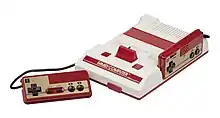
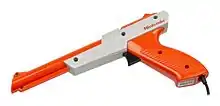
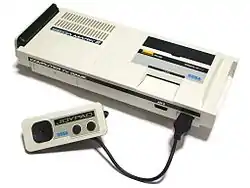 Sega Mark III/Master System (1985)
Sega Mark III/Master System (1985) Bubble Bobble (1986)
Bubble Bobble (1986)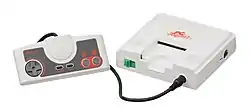 TurboGrafx-16/PC Engine (1987)
TurboGrafx-16/PC Engine (1987)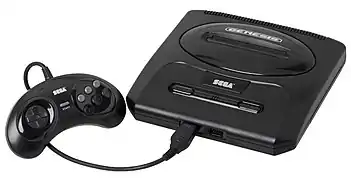 Sega Mega Drive/Genesis (1988)
Sega Mega Drive/Genesis (1988)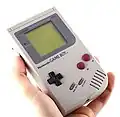 Game Boy (1989)
Game Boy (1989)
Notes
- ↑ Game & Watch version sold 8 million.[57] ColecoVision version sold 2 million.[58] Atari VCS version sold 4 million in 1982,[59] and 180,523 between 1987 and 1990.[60] Famicom version sold 840,000.[61] Atari 8-bit computer version sold 25,502.[60]
- ↑ Pac-Man:
- Atari 2600 version (1982) – 8,095,586 game cartridges (7,956,413 by 1983,[62] 139,173 between 1986 and 1990)[60]
- Coleco tabletop version (1982) – 1.5 million units[63]
- Pac-Man Nelsonic Game Watch (1982) – 500,000+ units[64]
- Family Computer (Famicom) version – 480,000 cartridges in Japan[65]
- Atari 5200 version – 35,011 cartridges (between 1986 and 1988)[60]
- Atari XE computer version – 42,359 copies (between 1986 and 1990)[60]
- Thunder Mountain's home computer budget release (1986) – 500,000+ copies[66]
- ↑ 1,318,655 in 1980. 2,964,137 in 1981. 1,373,033 in 1982. 435,353 in 1983.
- ↑ The Atari VCS version by Parker Brothers sold 4 million cartridges in 1982.[73] Sierra's home computer version sold more than 100,000 copies in the United States by 1985.[74]
- ↑ 3.575 million up until 1984.[87] 1.4 million in 1985.[88] 1.229 million in 1988.[89] 748,600+ in 1989.[90]
- ↑ See Market share of personal computer vendors § Japan.
References
- ↑ "The Video Game Crash of 1983".
- 1 2 "A 20-Year Old Legend".
- ↑ "Top 10 Embarrassing Moments in Video Game History".
- ↑ "Ten Facts about the Great Video Game Crash of '83". Archived from the original on 2012-01-21. Retrieved 2012-03-12.
- ↑ "Nintendo's DS family becomes best selling gaming handheld in history".
- ↑ "4th Generation Vintage Hardware and Computing Consoles". VintageGameSite.com. 2007-08-19. Archived from the original on December 22, 2008. Retrieved 2009-07-23.
- ↑ "Nintendo GameBoy - Reviews". Archived from the original on 2008-07-26. Retrieved 2009-12-31.
- ↑ Wolf, Mark J.P. (2008). The video game explosion: a history from PONG to PlayStation and beyond. ABC-CLIO. p. 103. ISBN 978-0313338687. Retrieved 2011-04-19.
- ↑ Wolf, Mark J.P. (2008). The video game explosion: a history from PONG to PlayStation and beyond. ABC-CLIO. p. 105. ISBN 978-0313338687. Retrieved 2011-04-19.
- ↑ "Pac-Man Fever". Time Magazine. 1982-04-05. Archived from the original on November 7, 2007. Retrieved 2009-10-15.
- ↑ "Top 20 cult films, according to our readers". The Boston Globe. 17 August 2006.
- ↑ John Hubner; William F. Kistner Jr (1983-11-28). "What went wrong at Atari". InfoWorld.
- ↑ "Classic Gaming Expo: ALAN MILLER". Archived from the original on 2012-02-08.
- ↑ "The History Of Activision".
- ↑ Beller, Peter C. (2 February 2009). "Activision's Unlikely Hero". Forbes.
- ↑ "Chase the Chuck Wagon". Archived from the original on 2012-02-29. Retrieved 2012-03-12.
- ↑ "History of the Video Game Console : 1980s".
- ↑ "A History of Video Game Consoles". Time. Archived from the original on January 20, 2011.
- ↑ "Five Million E.T. Pieces".
- ↑ "All Your History: The Video Game Crash of 1983".
- ↑ "10 Ridiculous Old-School Video Game Rumors (That Were Actually True)".
- ↑ "The Video Game Crash of 1983".
- ↑ "80's Radio Shack Color Computer Commercial". Archived from the original on 2021-12-20.
- ↑ "Commodore VIC-20 ad with William Shatner". Archived from the original on 2021-12-20.
- ↑ "Jordan Mechner's Karateka remake looks to modernize a classic story".
- ↑ Hague, James. "Why Do Dedicated Game Consoles Exist?".
- ↑ "Striking a BalanceIs Nintendo digging its grave with shovelware?".
- ↑ Uncle John's Legendary Lost Bathroom Reader. Portable Press. September 1999. p. 373. ISBN 978-1-879682-74-0.
In 1982 alone, Americans pumped $6 billion in quarters into Pac-Man's mouth—more than they spent in Las Vegas casinos and movie theatres combined.
- ↑ Uncle John's Legendary Lost Bathroom Reader. Simon and Schuster. November 2012. p. 348. ISBN 978-1-60710-670-8.
In 1982 alone, Americans pumped $6 billion in quarters into Pac-Man's mouth—more than they spent in Las Vegas casinos and movie theatres combined.
- ↑ "Racing Games Roundup: Facts". Guinness World Records Gamer's Edition. Little Brown Books. 2008. p. 154.
- 1 2 "Commando: Soldier of Fortune". Your Sinclair. No. 1. January 1986. p. 54.
- ↑ "Michael Jackson Sweeps AMOA Awards; 'Pole Position' Wins In Games Division" (PDF). Cash Box. November 10, 1984. pp. 31, 33.
- ↑ "Top Hits of Last 5 Years". RePlay. March 1987.
- ↑ "1985". Play Meter. Vol. 20, no. 13. December 1994. p. 74.
- ↑ "1985 Operator Survey: This Poll Says Go Gettum!". RePlay. Vol. 11, no. 2. November 1985. pp. 91-102 (93-4).
- ↑ "Game Machine's Best Hit Games 25: '86 上半期" [Game Machine's Best Hit Games 25: First Half '86] (PDF). Game Machine (in Japanese). No. 288. Amusement Press, Inc. 15 July 1986. p. 28.
- ↑ "Game Machine's Best Hit Games 25: '86 下半期" [Game Machine's Best Hit Games 25: Second Half '86] (PDF). Game Machine (in Japanese). No. 300. [musement Press, Inc. 15 January 1987. p. 16.
- ↑ "1986 Top Ten Coin-Ops". Sinclair User. No. 59. February 1987. p. 96.
- ↑ "1986". Play Meter. Vol. 20, no. 13. December 1994. p. 76.
- ↑ "Top 20 of 1986". Top Score. Amusement Players Association. July–August 1987. p. 3.
- ↑ "87' ゲーメスト大賞" [87' Gamest Awards]. Gamest (in Japanese). Vol. 17 (February 1988). December 28, 1987. pp. 26–38.
- ↑ "Game Machine's Best Hit Games 25: '87" (PDF). Game Machine (in Japanese). No. 324. Amusement Press, Inc. 15 January 1988. p. 20.
- ↑ "1987". Play Meter. Vol. 20, no. 13. December 1994. p. 78.
- ↑ "第2回ゲーメスト大賞" [2nd Gamest Awards]. Gamest (in Japanese). Vol. 29 (February 1989). December 27, 1988. pp. 26–41.
- ↑ "Game Machine's Best Hit Games 25: '88 / "Game of the Year '88" By Game Machine" (PDF). Game Machine (in Japanese). No. 348. Amusement Press, Inc. 15 January 1989. pp. 10–1, 26.
- ↑ "The World's Largest Arcade". ACE. No. 20 (May 1989). 6 April 1989. p. 23.
- ↑ "Coin-Ops: SU Awards '88". Sinclair User. No. 82 (January 1989). 18 December 1988. pp. 98–9.
- ↑ "1988". Play Meter. Vol. 20, no. 13. December 1994. p. 80.
- 1 2 "Videos of The Year; "Tetris", "Chase H.Q."" (PDF). Game Machine (in Japanese). No. 372. Amusement Press, Inc. 15 January 1990. p. 26.
- ↑ "第3回 ゲーメスト大賞" [3rd Gamest Awards]. Gamest (in Japanese). Vol. 41 (February 1990). December 27, 1989. pp. 52–79.
- ↑ "AMOA Jukebox, Games & Cigarette Vending Awards Winners". Cash Box. Cash Box Pub. Co. 1989-09-30. p. 36.
- ↑ "Special Report: 1989's Best Videos and Pins". RePlay. Vol. 15, no. 4. January 1990. pp. 44, 46, 4.
- ↑ Stewart, Keith (September 13, 2010). "Super Mario Bros: 25 Mario facts for the 25th anniversary". The Guardian. Archived from the original on August 25, 2017. Retrieved March 14, 2018.
- ↑ Saltzman, Marc (June 12, 2009). "'Tetris' by the numbers". USA Today. Retrieved June 13, 2009.
- ↑ Welch, Hanuman (April 23, 2013). "1984: Duck Hunt - The Best Selling Video Game Of Every Year Since 1977". Complex. Archived from the original on April 24, 2017. Retrieved April 26, 2017.
- 1 2 3 O'Malley, James (September 11, 2015). "30 Best-Selling Super Mario Games of All Time on the Plumber's 30th Birthday". Gizmodo. Archived from the original on February 28, 2017. Retrieved April 26, 2017.
- ↑ Epstein, David (27 June 2019). "Chapter 9: Lateral Thinking with Withered Technology". Range: Why Generalists Triumph in a Specialized World. Pan Macmillan. p. 196. ISBN 978-1-5098-4351-0.
The Donkey Kong Game & Watch was released in 1982 and alone sold eight million units.
- ↑ McFerran, Damien (18 September 2010). "Feature: How ColecoVision Became the King of Kong". Nintendo Life. Retrieved 2 April 2021.
- ↑ Kitchen, Garry E. (March 5, 2010). "Garry E. Kitchen". Expert Report of Garry E. Kitchen (PDF). United States District Court for the Southern District of Ohio. p. 2.
Designed & programmed Atari 2600 adaptation of hit arcade game Donkey Kong, 1982 wholesale revenues in excess of $100 million on 4 million units.
- 1 2 3 4 5 Vendel, Curt (May 28, 2009). "Site News". Atari Museum. Archived from the original on 2010-12-06. Retrieved 2021-11-27.
- ↑ "Japan Sales". Nintendojo. September 26, 2006. Archived from the original on July 30, 2008. Retrieved October 9, 2008. (Translation Archived June 30, 2021, at the Wayback Machine)
- 1 2 Cartridge Sales Since 1980. Atari Corp. Via "The Agony & The Ecstasy". Once Upon Atari. Episode 4. Scott West Productions. August 10, 2003. 23 minutes in.
- ↑ "Coleco Mini-Arcades Go Gold" (PDF). Arcade Express. 1 (1): 4. August 15, 1982. Archived (PDF) from the original on November 8, 2012. Retrieved February 3, 2012.
- ↑ Shea, Tom (20 December 1982). "Shrinking Pac-Man leads game-wristwatch market". InfoWorld. Vol. 4, no. 50. InfoWorld Media Group, Inc. pp. 44–5. ISSN 0199-6649.
- ↑ "Game Search (based on Famitsu data)". Game Data Library. March 1, 2020. Archived from the original on April 24, 2019. Retrieved March 16, 2020.
- ↑ Worley, Joyce (December 1989). "Mega Hits: The Best of the Best". Video Games & Computer Entertainment (11): 130–132, 137, 138.
- ↑ Director/Producer: Magnus Temple; Executive Producer: Nick Southgate (2004). "Tetris: From Russia With Love". BBC Four. Event occurs at 51:23. BBC. BBC Four.
The real winners were Nintendo. To date, Nintendo dealers across the world have sold 8 million Tetris cartridges on the Nintendo Entertainment system.
- ↑ "March 25, 2004". The Magic Box. March 25, 2004. Archived from the original on November 26, 2005. Retrieved April 1, 2007.
- 1 2 "Mark Cale interrogation". Retro Gamer (18): 56-57 (57). October 2005.
- ↑ Dawson, Angela (1998). "Pitfall Harry to Life for Activision". Adweek. A/S/M Communications. p. 4.
The pit-hopping action game has sold more than 5 million copies worldwide.
- ↑ Parton, Rob (March 31, 2004). "Xenogears vs. Tetris". RPGamer. Archived from the original on February 2, 2013. Retrieved April 6, 2008.
- ↑ CESA Games White Papers. Computer Entertainment Supplier's Association.
- ↑ "Ed English: 2600 (Frogger, Mr. Do!, Roc 'n Rope)" (PDF). Digital Press. No. 52. May–June 2003. p. 7. Retrieved 19 April 2021.
- ↑ Petska-Juliussen, Karen; Juliussen, Egil (1990). The Computer Industry Almanac 1990. New York: Brady. pp. 3.10-11. ISBN 978-0-13-154122-1.
- ↑ "That's Edutainment". Billboard. Nielsen Business Media. 107 (19): 91. May 1, 1995. ISSN 0006-2510. Retrieved August 8, 2009.
- ↑ Kent, Steven L. (June 16, 2010). The Ultimate History of Video Games: From Pong to Pokémon and Beyond... The Story Behind the Craze That Touched Our Lives and Changed the World. New York City, New York: Crown Archetype. p. 571. ISBN 978-0761536437. Retrieved April 22, 2017.
- ↑ "About Lionhead Studios". Lionhead Studios. Archived from the original on December 11, 2007. Retrieved January 8, 2008.
- 1 2 3 小川 (Ogawa), 純生 (Sumio) (2010-12-14). "テレビゲーム機の変遷 —ファミコン、スーパーファミコン、プレステ、プレステ2、Wiiまで—" [Recent Developments in Video Game Technology in Japan — Famicom, Super Famicom, Play Station, Play Station 2 and Wii —] (PDF). 経営論集 (Keiei Ronshū) (in Japanese) (published March 2011) (77): 1-17 (2). ISSN 0286-6439. Archived from the original (PDF) on 2015-07-25. Retrieved 2021-12-06 – via Toyo University Academic Information Repository (Toyo University).
- 1 2 Ramirez, Anthony (1990-12-08). "Waiting for the Zapping of Nintendo". The New York Times. ISSN 0362-4331. Retrieved 2021-12-09.
- 1 2 "Europe: consoles contre micros" [Europe: consoles against microphones]. Tilt (in French). pp. 23 to 24.
- 1 2 게임월드 [Game World] (in Korean). 1994.
- ↑ Vogel, Harold L. (2010-12-20). Entertainment Industry Economics: A Guide for Financial Analysis. Cambridge University Press. p. 397. ISBN 978-1-139-49732-9.
- ↑ "昔(1970年代)のテレビゲームは何台売れた?" [How many old (1970s) video games sold?]. Classic Videogame Station Odyssey (in Japanese). Archived from the original on 2014-01-09. Retrieved 16 April 2021.
- ↑ Japan Company Handbook. Toyo Keizai. 1982. p. 729.
In Aug. '82 term, sales of "Game & Watch" will increase from 4.6 million to 7 million units
- ↑ "Where every home game turns out to be a winter". The Guardian. 6 March 1986. p. 15. Retrieved 3 October 2021.
- ↑ Rubin, Michael (2006). "Eighteen: A Hole in the Desert [1982–1983]" (PDF). Droidmaker: George Lucas and the Digital Revolution. Triad Publishing Company. pp. 291-314 (293-4). ISBN 978-0-937404-67-6.
- 1 2 3 4 5 6 Reimer, Jeremy (2005-12-15). "Total share: 30 years of personal computer market share figures". Ars Technica. Retrieved 2021-11-27.
- Jeremy Reimer (2012-12-07). "Total Share: Personal Computer Market Share 1975-2010". Jeremy Reimer.
- ↑ Dixon, Bradford N. (May 1986). "Pulse Train: Fine Times in Fort Worth" (PDF). 80 Micro. No. 76. pp. 21–2.
- ↑ The Bandito (September 1989). "Roomers: Number Crunching". Amazing Computing for the Commodore Amiga. Vol. 4, no. 9. pp. 67-70 (69-70).
- 1 2 "Amid industry pessiminism, micro sales rose". Computerworld. Vol. 24, no. 2. IDG Enterprise. 8 January 1990. p. 34. ISSN 0010-4841.
- ↑ Sheff, David (1994). Game Over: How Nintendo conquered the world (1st Vintage books ed.). New York: Vintage Books. ISBN 9780307800749. OCLC 780180879. Retrieved July 27, 2019.
- ↑ Watanabe, Teresa (1990-06-10). "Toward Creativity In Japan : 'Steve Jobs of Japan' Dispels Old Myths". Los Angeles Times. Retrieved 2021-12-12.
- ↑ Tanaka, Tatsuo (August 2001). Network Externality and Necessary Software Statistics (PDF). Statistics Bureau of Japan. p. 2.
- ↑ "Comparing the New Videogame Systems" (PDF). Computer Entertainer. Vol. 5, no. 11. February 1987. p. 13.
- ↑ "Las Vegas, un coup de joystick dans le sable" [Las Vegas, a joystick in the sand]. Tilt (in French). No. 52. March 1988. pp. 18-23 (19).
- ↑ "Holiday Gift Guide: Fantasy Games Remain Popular With Young Video Fans". Aiken Standard. 1 December 1988. p. 21. Retrieved 8 December 2021.
- ↑ Hayes, Thomas C. (1984-02-04). "Mattel Is Counting on Its Toys". The New York Times. ISSN 0362-4331. Retrieved 2021-12-11.
- ↑ "More Mini-Arcades Coming From Coleco" (PDF). Arcade Express. Vol. 1, no. 13. January 30, 1983. p. 2.
- ↑ Rothstein, Edward (1990-04-26). "Electronics Notebook; Adventures in Never-Never Land". The New York Times. ISSN 0362-4331. Retrieved 2021-12-09.
- ↑ "Asiaweek". Asiaweek. 1991. p. 2.
Introduced in 1989, Game Boy sold 2.5 million units that year and 10 million in 1990.
- ↑ European Plastics News. Vol. 11. IPC Press. 1984. p. 26.
The familiar ZX 81 and Spectrum computers have been produced in vast quantities. Total sales are in excess of 2.3 million units
- ↑ McFerran, Damien (18 September 2010). "Feature: How ColecoVision Became the King of Kong". Nintendo Life. Retrieved 2 April 2021.
- ↑ "Guerre Dans Le Salon" [War in the Living Room]. Science & Vie Micro (in French). No. 67. December 1989. pp. 126–8.